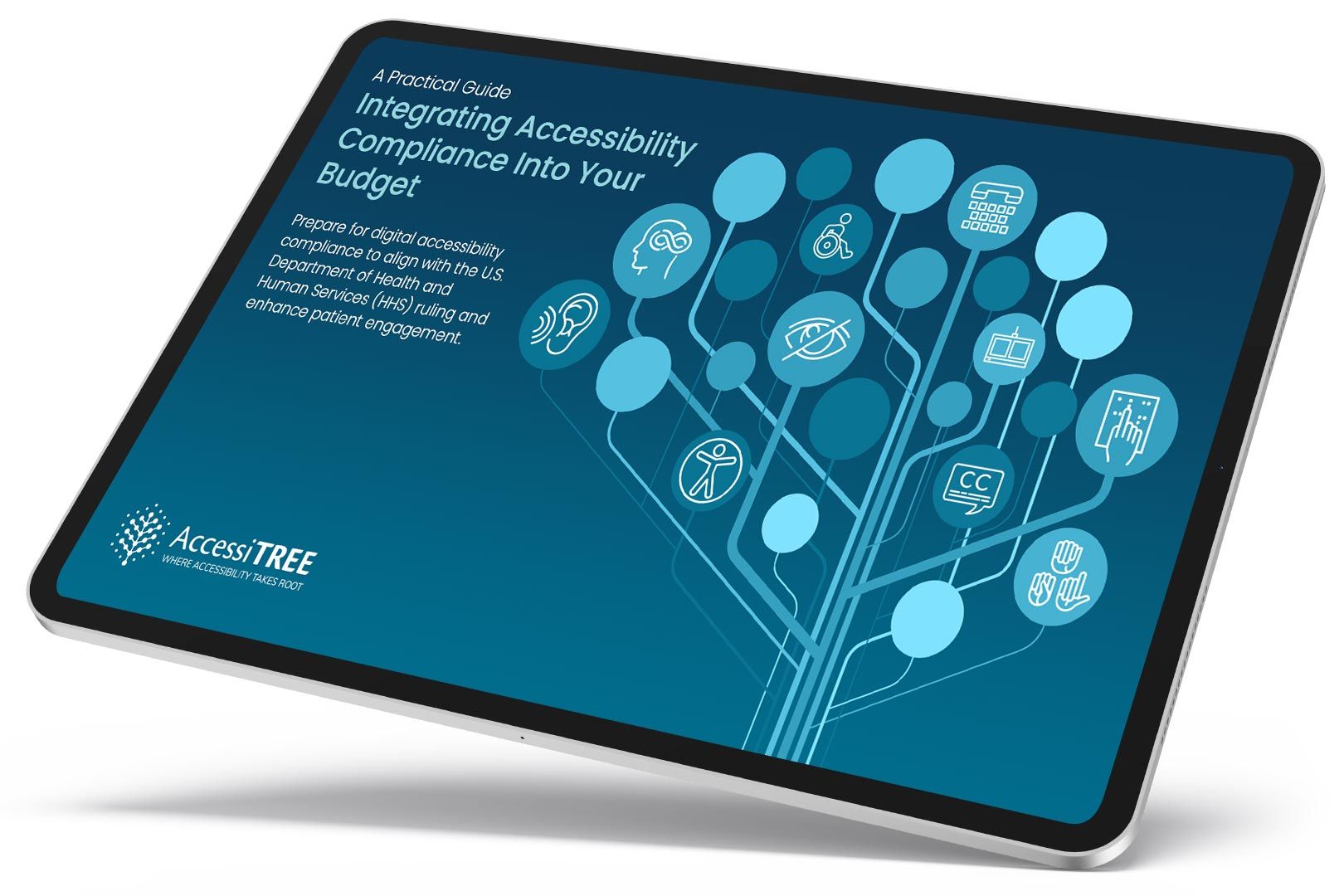
Navigating the New HHS Section 504 Rule
The Changing Face of Healthcare Access Regulation
The role of digital accessibility in healthcare cannot be overemphasized as it ensures that all people, irrespective of ability, have access to essential health information and services. One of the most significant advances in this respect is the U.S. Department of Health and Human Services (HHS) Final Rule of May 2024, which updates Section 504 of the Rehabilitation Act of 1973. This is not merely an incremental update; it represents the first comprehensive revision of these regulations in nearly five decades. This landmark rule reflects over 50 years of advocacy by the disability community and aims to deeply embed non-discrimination principles into all HHS-funded programs and activities. The extensive history and foundational nature of this update signal a long-term, unwavering commitment from HHS. Therefore, healthcare organizations need to view compliance in terms of not a set of discrete projects to meet near-term deadlines, but as a means to establish and sustain vigorous, ongoing accessibility programs. This book provides a straightforward guide for healthcare compliance officers to comprehend and get ready for the new Section 504 digital accessibility regulations, emphasizing key deadlines and take-away actions to establish an environment of inclusive care.
Interpreting the Underlying Mandates of the Amended HHS Section 504 Rule
Section 504 of the Rehabilitation Act broadly prohibits discrimination based on disability in programs or activities that receive Federal financial assistance from HHS. This mandate extends to a wide variety of healthcare organizations, including hospitals, clinics, insurance companies, and any entity that receives funding from HHS, which often includes private entities that receive Medicare or Medicaid payments.
The new rule places stringent digital accessibility requirements center stage. At the top of the list is the mandate that websites, mobile applications, and other web-based applications or digital documents be compliant with the Web Content Accessibility Guidelines (WCAG) 2.1 Level AA. This mandate applies to a broad array of digital patient touchpoints, but is not exhaustive of:
- Public websites
- Patient portals
- Electronic Health Record (EHR) systems (interfaces and documents)
- Web-enabled registration forms, appointment forms, and other transaction forms
- Kiosks (although as comprehensive U.S. technical standards further develop, EN 301 549 is a useful interim standard for these closed-functionality devices)
- Email messages
- Telehealth platforms
The regulation’s expansive definition of “programs or activities” that receive federal financial assistance implies that accessibility obligations could reach beyond systems that are directly patient-facing. If internal systems, tools, or communications are included in making available HHS-funded services—e.g., an internal training site for personnel offering an HHS-funded patient program—these would also be covered by the accessibility obligations. This calls for a full audit of all external and internal digital touchpoints to achieve complete compliance.
Critical Compliance Deadlines
The HHS Section 504 Final Rule took effect on July 8, 2024. The rule includes phased deadlines for digital accessibility compliance, depending on the organization’s size:
- Organizations with 15 or more employees: Web content on the internet and mobile applications that serve patients must meet WCAG 2.1 Level AA by May 11, 2026.
- Organizations with fewer than 15 employees: Patient-facing web content and mobile applications must conform to WCAG 2.1 Level AA by May 10, 2027.
These timeframes refer to the necessity of expediency in taking action. Health care organizations have 6- to 12-month or longer development and procurement cycles for software and digital platforms. Planning and work towards accessibility must be started now to be able to comply with the 2026 and 2027 timeframes.
The phased compliance deadlines based on employee numbers, though giving less time to smaller organizations, also threaten to introduce a temporary lopsidedness in the availability of healthcare services. Patients, especially those who are disabled, engage with many providers and systems. With larger organizations getting on board earlier, patient expectations of digital accessibility will inevitably increase across the board. If smaller players lag behind their accessibility efforts, they may be competitively disadvantaged, even if technically compliant with the next deadline. Disabled patients may be naturally attracted to more accessible and user-friendly digital experiences provided by more progressive providers, which can impact patient retention and patient acquisition for lagging adopters.
Actionable Roadmap for Compliance Officers (2025-2026)
There has to be a systematic way to chart the path to compliance. The roadmap below identifies major activities for 2025 and 2026:
Q1-Q2 2025: Planning & Assessment
- Inventory Digital Assets: Conduct a thorough inventory of all patient-facing and relevant internal digital assets. This includes websites, mobile apps, patient portals, EHR interfaces, digital documents (PDFs, online forms), self-service kiosks, and telehealth platforms. AccessiTREE’s approach of “No guesswork—just measurable progress” can provide a clear framework for this crucial first step.
- Define WCAG Baseline: The law requires WCAG 2.1 Level AA. That does not mean, however, that organizations cannot consider adopting WCAG 2.2 Level AA as their internal baseline. WCAG 2.2 includes additional success criteria that cover the more contemporary accessibility requirements and will future-proof the compliance efforts.
- Gap Analysis & Risk Assessment: Conduct a thorough gap analysis to determine areas of non-compliance with the selected WCAG standard. Prioritize remediation based on high-traffic, high-risk areas and essential patient services.
- Budgeting: Provide sufficient budget in every area of the accessibility program, such as remediation, accessibility testing tools, employee training, and possible third-party vendor assistance. AccessiTREE provides solutions to fit diverse budgets and operational requirements, making accessibility achievable.
Q3-Q4 2025: Policy & Procurement
- Develop/Refresh Accessibility Policy: Establish or update the company’s formal policy on digital accessibility. The policy should formally adopt WCAG 2.1 AA (or 2.2 AA) as the internal standard and define roles, responsibilities, and accountability for accessibility within various departments.
- Strengthen Vendor Contracts: Strengthen all digital vendor contracts with third-party vendors (EHR vendors, patient portal vendors, telehealth platform vendors, etc.) to incorporate explicit requirements for WCAG compliance. Demand proof of conformance, such as an Accessibility Conformance Report (ACR) based on the Voluntary Product Accessibility Template (VPAT®). This is particularly critical as the HHS rule extends responsibility to content and tools provided through contractual arrangements. Services like AccessiTREE’s ProcureEnsure can assist in validating vendor accessibility claims.
- Staff Training: Give extensive training to all of the involved staff, including developers and designers, content creators, procurement officials, and patient-facing staff. The training should cover the new HHS rule mandates, WCAG basics, and practical accessibility best practices. AccessiTREE is well-equipped to fill such knowledge gaps in healthcare organizations.
Q1-Q4 2026: Implementation & Validation
- Remediation Efforts: Manage and initiate remediation of discovered accessibility problems. This can be achieved via in-house personnel, outside vendors, or a mix. AccessiTREE offers customizable service models, such as full-service remediation where their experts undertake the technical effort, or self-service support with expert support for in-house staff.
- Embed Accessibility in Workflows: Include accessibility in all relevant organizational workflows. This includes design processes, software development lifecycles (SDLC), content creation and publication, quality assurance (QA) testing, and procurement processes.
- Testing: Employ a strict testing methodology that combines automated accessibility scanning tools with thorough manual testing by accessibility experts. Above all, incorporate usability testing by a diverse range of individuals with disabilities to confirm real-world effectiveness.
- Documentation: Keep scrupulous records of all accessibility work. These consist of audit reports, remediation measures taken, training documentation, policy statements, and user comment logs. This record is required to demonstrate due diligence and accountability.
Continuous Monitoring & Maintenance
- Establish a routine of regular accessibility health checks, both through automated tools as well as manual checking, to maintain ongoing compliance as digital assets evolve.
- Develop an open process for monitoring user feedback on accessibility, provided through channels like an accessibility statement feedback mechanism, and addressing reported problems within a reasonable timeframe.
- Keep up to date with new accessibility standards (e.g., WCAG future versions), regulatory developments, and the development of assistive technologies.9 AccessiTREE offers its clients this continual advice and assistance.
This strategy stresses that digital accessibility is not a project with an end date but a continuous process of refinement and vigilance. Focus on integrating accessibility into the overall organizational environment and processes is paramount. Digital platforms and content are not static; new features are added, content changes, and third-party tools evolve. Absent systemic embracing of accessibility best practices, any remediation done at the outset will instantly be outdated, and non-compliance will again follow. This necessitates culture transformation in healthcare organizations, moving accessibility from an isolated IT or compliance project to a responsibility that cuts across several departments, i.e., IT, marketing, legal, procurement, and clinical operations.
Exceptions and Nuances in the HHS Rule
The HHS Section 504 Final Rule includes explicit, limited exceptions to the requirement of WCAG 2.1 AA conformance:
- Archived web content: The content that is retained only for reference, research, or record-keeping is not updated or changed after being archived, and is moved to a separate section for archives.
- Legacy traditional electronic documents: This includes documents like PDFs, Word documents, or spreadsheets that were in existence or published before the entity’s compliance date (May 2026 or May 2027). There is a single exception, though, and it’s an important one: this exception does not apply where such documents are being utilized by individuals to apply for, access, or take part in a recipient’s program or activity. Therefore, the majority of patient-facing PDFs, including intake forms, consent forms, financial assistance applications, and educational brochures on websites or patient portals, and being utilized in the patient process, will need remediation. This is a significant undertaking that organizations might overlook if they misinterpret the scope of this exception. AccessiTREE’s expertise in document remediation, including services leveraging tools like CommonLook Clarity, is highly pertinent to addressing this challenge.
- Third-party content: This typically refers to content on a company’s website or mobile application that has been posted there by someone other than the company (e.g., forum comments), as long as the company does not control or create such content through contractual, licensing, or other agreements.
- Individual, password-protected or otherwise limited standard electronic documents: This would include documents specific to an individual, like a lab report for a patient or an explanation of benefits provided through a secure patient portal. These individual documents aren’t necessarily required to actively comply with WCAG 2.1 AA, yet the recipient needs to provide them in an accessible, usable format upon request by an individual with a disability within a timely fashion.
- Pre-existing social media messages: Social media messages that were posted by the recipient before their compliance date are not included.
The rule also permits the use of a “conforming alternate version” of inaccessible content under very strict conditions. This alternate version must provide all the same information and functionality as the original, be as up-to-date, and users with disabilities must be able to reach it as easily as the inaccessible version. It cannot be defended on grounds of cost, time, or shortage of expertise, and should be phased out as soon as the original material is available. This is an emergency solution, not a long-term one.
For kiosks, the rule requires equal access. If the kiosk’s hardware or software is not yet fully accessible, the alternative process available to individuals with disabilities must grant the same degree of access, convenience, and confidentiality that is afforded to other patients.
The Position of a Trusted Partner like AccessiTREE
It can be daunting for healthcare organizations to navigate the complexities of the new HHS Section 504 rule and achieve overall digital accessibility. An experienced partner like AccessiTREE can be a huge help. AccessiTREE provides solution-based solutions, such as expert consulting, comprehensive website and document remediation, self-service support portals, ongoing monitoring and maintenance, and creation of critical documentation such as Accessibility Statements. With an underlying philosophy of “Compliance Made Easy, Accessibility Made Real” propels AccessiTREE’s services to healthcare providers, easing the path to digital inclusion.
Proactive Compliance as a Basis for Equitable Care
The new HHS Section 504 rule is a big leap forward in making digital healthcare available to everyone. For compliance officers, the takeaway is simple: it will take active and ongoing effort to achieve these new standards. The deadlines are looming, and the range of digital assets affected is wide. Yet this challenge also presents an opportunity to improve patient care, increase reach, and cement an organization’s reputation as a champion of health equity. Digital accessibility is not only a legal requirement but also an essential aspect of delivering high-quality, equitable care in the 21st century. Healthcare organizations should not delay starting their path toward compliance. Consulting experts like AccessiTREE can provide the necessary advice and guidance to navigate these requirements effectively and confidently.

Need Help With Digital Accessibility?
Our team is here to guide you through the process of meeting accessibility standards. Contact us today to get started.

A practical guide for healthcare leaders navigating WCAG compliance.
